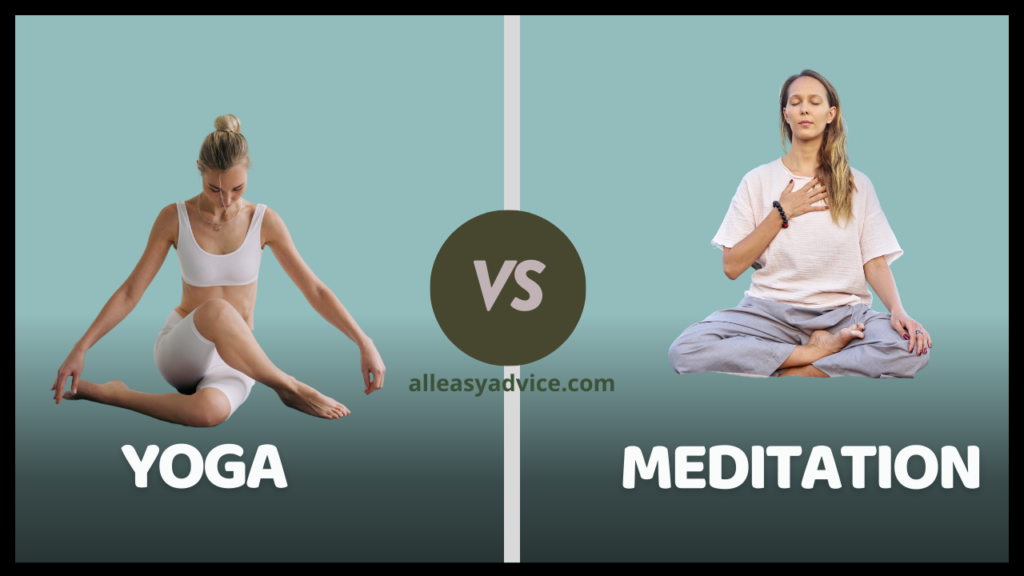Yoga vs Meditation: Which Practice is Right for You? To choose it, you need to know more about the benefits of yoga and the benefits of meditation. By realizing the difference between the benefits of yoga and meditation and how pleasant or harmful it is for us, it will be very easy to understand which is more important for us yoga and meditation. So, if you want to get the benefits of yoga and meditation, read our article today in detail. So let’s go and read more.

Overview of Yoga vs Meditation
| Aspect | Yoga | Meditation |
|---|---|---|
| This can be done in shorter time periods | Physical, mental, and spiritual practice | Mental practice focused on mindfulness |
| Purpose | Balance body, mind, and spirit | Cultivate awareness, calmness, and clarity |
| Techniques | Asanas (postures), Pranayama (breath control) | Mindfulness, concentration, visualization |
| Physical Benefits | Improved flexibility, strength, and posture | None (primarily mental practice) |
| Mental Benefits | Stress reduction, focus, emotional well-being | Stress reduction, enhanced self-awareness |
| Spiritual Aspect | An integral part of some of the connection with divinity | stationary, seated, or lying down |
| Movement | Involves physical movement and poses | An integral part of some of the connections with divinity |
| Focus | Body and breath awareness | Breath, thoughts, sensations, or mantras |
| Styles and Types | Hatha, Vinyasa, Iyengar, etc. | Mindfulness, loving-kindness, Transcendental |
| Time Commitment | An integral part of some of the connections with divinity | Can be done in shorter time periods |
| Applicability | Physical fitness, stress relief, holistic health | Stress management, personal growth |
| Historical Origin | Ancient Indian practice with various traditions | Also ancient, practiced across cultures |
youtube yoga meditation
Also, Read- Yoga Vs. Running: A Comparative Analysis of the Physical, Mental, and Emotional Benefits
Yoga vs. Meditation
Which is better yoga and meditation or how effective are these two for us and what are their benefits?
Read the following important topics carefully to know about them. Hope our short discussion will help you to check out the features, variations and what is best for our body of yoga and meditation.
What is yoga?
Yoga is a holistic practice originating from ancient India that combines physical postures, controlled breathing, and meditation to promote physical, mental, and spiritual well-being. It aims to enhance flexibility, strength, and relaxation while fostering inner peace and mindfulness. With various styles and approaches, yoga offers a versatile path toward self-awareness and balance.
Yoga and Meditation Benefits
Yoga and meditation are practices that have been around for centuries and are known for their numerous physical, mental, and emotional benefits. Here are some of the key benefits of both practices:
Yoga:
- Improved Flexibility: Regular yoga practice can increase your flexibility by stretching and lengthening your muscles. This can help improve your range of motion and reduce the risk of injuries.
- Increased Strength: Many yoga poses require you to support your body weight in various ways, which can help build and tone muscles.
- Stress Reduction: Yoga often incorporates mindfulness and deep breathing techniques, which can help activate the body’s relaxation response and reduce stress levels.
- Better Posture: Yoga emphasizes awareness of your body and alignment during poses, leading to improved posture both on and off the mat.
- Pain Relief: Yoga can help alleviate chronic pain conditions like lower back pain, arthritis, and migraines. It promotes better circulation and can reduce muscle tension.
- Enhanced Breathing: Yoga encourages focused breathing techniques, which can improve lung capacity, oxygenate the body, and promote relaxation.
- Mind-Body Connection: Yoga emphasizes the connection between the mind and body, promoting self-awareness and a sense of balance.
- Cardiovascular Health: Some forms of yoga, such as Vinyasa or Power Yoga, can provide a cardiovascular workout that improves heart health.
- Weight Management: Regular yoga practice can contribute to weight loss by increasing metabolism and promoting mindful eating habits.
Meditation:
- Stress Reduction: Meditation is known for its ability to reduce stress by promoting relaxation and calming the mind. It can lead to decreased levels of the stress hormone cortisol.
- Improved Focus and Concentration: Regular meditation practice can enhance your ability to concentrate, make decisions, and stay focused on tasks.
- Enhanced Emotional Well-being: Meditation can help regulate emotions and promote feelings of happiness and contentment. It’s often used in mindfulness-based therapies to manage anxiety and depression.
- Increased Self-Awareness: Meditation encourages self-reflection and self-awareness, helping you gain a deeper understanding of your thoughts, emotions, and behaviors.
- Better Sleep: Mindfulness meditation techniques can promote better sleep by relaxing the body and calming racing thoughts.
- Reduced Anxiety: Meditation practices can reduce symptoms of anxiety disorders by promoting relaxation and helping individuals detach from anxious thoughts.
- Pain Management: Mindfulness meditation can help individuals cope with chronic pain by changing their perception of pain and increasing their pain tolerance.
- Lower Blood Pressure: Meditation has been associated with lower blood pressure levels, contributing to overall cardiovascular health.
- Enhanced Creativity: Meditation can boost creativity by allowing the mind to wander freely and make novel connections between ideas.
Both yoga and meditation have a wide range of benefits, and incorporating them into your routine can lead to improved physical health, mental clarity, and emotional well-being. It’s important to remember that consistent practice is key to experiencing these benefits. If you’re new to these practices, consider starting with beginner-friendly classes or guided sessions to help you get started.
Yoga vs. Meditation for Anxiety
Yoga and meditation are both effective practices for managing anxiety. Yoga combines physical postures, controlled breathing, and relaxation techniques, promoting mind-body harmony. Meditation involves focusing the mind and achieving a state of calm and mindfulness. While yoga engages the body and mind, meditation specifically targets mental stillness. The choice between them depends on personal preference; some find relief through the physicality of yoga, while others prefer the mental clarity attained through meditation. Combining both can offer a holistic approach to anxiety management.
Yoga vs Meditation Reddit
Yoga and meditation are often intertwined practices with distinct focuses. Yoga involves physical postures (asanas) and breath control, promoting flexibility, strength, and balance. It integrates body and mind, enhancing mindfulness through movement. Meditation, on the other hand, emphasizes stillness and mental concentration. It cultivates awareness, reduces stress, and promotes mental clarity. While yoga offers a holistic approach by merging physical and mental aspects, meditation delves deeply into calming and focusing the mind, each catering to different preferences in achieving overall well-being.
Relationship Between Yoga and Meditation
Yoga and meditation are closely intertwined practices that share a harmonious relationship. Yoga encompasses physical postures (asanas), breath control (pranayama), and meditation techniques to cultivate mental and physical well-being. Meditation is a fundamental component of yoga, helping practitioners achieve inner stillness, heightened awareness, and a tranquil state of mind. While yoga prepares the body for meditation through flexibility and relaxation, meditation enhances mindfulness and concentration, complementing the holistic benefits of yoga. Together, they create a holistic approach to health, fostering a balance between body, mind, and spirit.
Final Comments
Yoga and meditation offer transformative journeys within. Through intentional movement and breath in yoga and the cultivation of mindfulness in meditation, we unlock the power to balance our physical, mental, and emotional well-being.
These practices teach us to embrace the present moment, fostering clarity and inner peace. Regular engagement can lead to heightened self-awareness, reduced stress, and a deeper connection to ourselves and the world around us. Embracing yoga and meditation is a gift we give ourselves for a more harmonious and fulfilling life.
Why yoga is better than meditation?
It’s inaccurate to say that yoga is inherently better than meditation or vice versa, as both practices offer unique benefits and serve different purposes. Yoga and meditation are actually complementary practices that can work well together.
Do I need to meditate if I do yoga?
Meditation and yoga are closely related practices, but they serve distinct purposes. While yoga involves physical postures (asanas) and breath control (pranayama) that promote flexibility, strength, and relaxation, meditation focuses on calming the mind and achieving mental clarity.
Incorporating meditation into your yoga routine can enhance the overall experience by helping you cultivate mindfulness, reduce stress, and improve concentration. While not mandatory, meditation can complement yoga by fostering a deeper connection between your body and mind, fostering a sense of inner peace, and promoting holistic well-being.
Ultimately, the decision to include meditation in your yoga practice depends on your personal goals and preferences.
What is meditation in Islam?
In Islam, meditation is often referred to as “Tafakkur” or “Tadhakkur,” which means deep contemplation and reflection. It involves focusing one’s thoughts on the attributes of Allah (God), the teachings of the Qur’an, and the spiritual significance of life.
This practice aims to achieve a heightened state of awareness and connection with God, promoting inner peace, self-awareness, and spiritual growth. Muslims engage in meditation by pondering over verses from the Qur’an, reflecting on the universe’s creation, and contemplating their purpose in accordance with Islamic teachings.
The goal is to cultivate a mindful and grateful mindset while deepening the spiritual bond with Allah.
What is the difference between yoga and mindfulness meditation?
Mindfulness meditation practice focuses on mind-body knowledge rather than physical postures, but yoga positions aid in the integration of the body, mind, and spirit. Yoga is considered more comprehensive because it promotes mental, physical, and spiritual well-being. Yoga also raises the heart rate and keeps the veins healthy.
Should I meditate or do yoga first?
Ideally, Derfuss says meditation is best after yoga and breathwork since these practices balance the nervous system and stimulate your subtle energy. However, if yoga or breathwork isn’t something you do, then she recommends practicing after exercise.
Can I do both yoga and meditation?
Absolutely you can definitely practice both yoga and meditation. In fact, many people find that practicing these two disciplines together can be incredibly beneficial for overall well-being, mental clarity, and physical health.
Can Muslims do yoga?
Yes, Muslims can do yoga, but there are some considerations and variations to take into account due to the religious and cultural aspects of Islam. Yoga is a physical, mental, and spiritual practice that originated in ancient India. While it has spiritual elements, it is not inherently tied to any specific religion.
Yoga and Meditation for Mental Health
Yoga and meditation are powerful practices for promoting mental health. Engaging in regular yoga sessions helps reduce stress and anxiety by fostering a mind-body connection. Meditation cultivates mindfulness, enhancing self-awareness and decreasing rumination. Both practices increase the production of neurotransmitters like serotonin, fostering a sense of well-being. Incorporating yoga and meditation into your routine can contribute significantly to improving mental health.
Did Prophet Muhammad meditate?
Yes, it is believed that Prophet Muhammad, the founder of Islam, engaged in a form of spiritual meditation. One of the most well-known instances of his meditative practices is the period of seclusion and meditation in the cave of Hira on the outskirts of Mecca.
Why is 4 a.m. the best time to meditate?
In the morning, at sunrise: Traditionally, between 4 a.m. and 6 a.m., the Brahma Muhurta Sandhya is the most auspicious time to meditate, according to the ancients. The mind is calm and refreshed after a good night’s sleep, and the distractions of the day have yet to begin.
What is the first rule in meditation?
The first rule in meditation is to find a quiet and comfortable space. Sit or lie down in a relaxed position. Close your eyes and focus on your breath, letting go of any distractions or thoughts.
Yoga vs. Meditation: Which Is Better For Me?
Yoga combines physical movement and breath control to enhance flexibility and strength, promoting holistic well-being. Meditation involves focused mindfulness to cultivate mental clarity and reduce stress. Choose based on whether you prefer active engagement (yoga) or a quieter, contemplative approach (meditation) for your personal goals and preferences.
What is Yoga Meditation Called?
Yoga meditation, often referred to as “Dhyana” in traditional yoga practice, is a focused and contemplative technique aimed at achieving mental clarity and inner peace. Rooted in ancient Indian traditions, this practice involves stilling the mind, observing thoughts without attachment, and ultimately attaining a state of profound mindfulness. By integrating breath control, posture, and mental concentration, yoga meditation promotes holistic well-being and a deeper connection between mind, body, and spirit.
Also Read:




